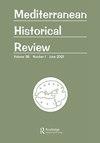Mediterranean encounters: trade and pluralism in early modern Galata
IF 0.2
2区 历史学
Q1 HISTORY
引用次数: 2
Abstract
Probably because cross-confessional, Mediterranean interaction is believed to have been in itself exceptional, a good deal of Ottoman history contents itself with description. The work under review goes beyond this narrow approach with an analytical, if not always problematic, quest for a casuistic view of piracy and litigation issues. White’s research is indebted to a revolutionary aspect of Ottoman history: unlike their medieval predecessors, Ottoman notarial practice was entrusted to kadis who endowed all their deeds with permanent validity and kept judicial archives. White is nonetheless aware of the limitations of Islamic court records, such as the summary transcriptions and the cumulative, chaotic character of registers, or sicils. To a greater extent, the chapter addresses one of the major problems of crossconfessional relations: the extent to which non-Muslim merchants and actors, for whom shariah presented wellknown biases and procedural obstacles, such as witnessing, made use of such courts. It also provides us with good descriptions of parallel jurisdictions such as the Kazasker and the Imperial Council. The chapter discusses a lawsuit passed before the kadi Sunullah Efendi, who later became şeyhülislam and authored the first fatwa collection dealing with piracy issues at length. We can see Sunullah at work in a 1594 case involving the Janissary Mahmud, that presented evidentiary problems and required careful handling of proof and evidence. White’s approach to court records offers more than a literal, legalistic reading. The chapter looks into the motivations and strategies of the plaintiffs, often non-Muslims, particularly for those cases where the procedural limitations of Islamic law would have made a positive outcome unlikely. Thick descriptions and a microhistorical approach substantiates one of White’s major arguments, namely, that what characterized the Ottoman Mediterranean was the actors’ awareness – be they foreign unbelievers, zimmis or Muslims – of the intricacies of Islamic law, a skill they exhibited when bringing their claims to court.地中海遭遇:近代早期加拉塔的贸易与多元化
可能是因为交叉忏悔,地中海的互动被认为是例外的,大量的奥斯曼历史内容本身就是描述。审查中的工作超越了这种狭隘的方法,对盗版和诉讼问题进行了分析(如果不是总是有问题的话),寻求一种诡辩的观点。怀特的研究得益于奥斯曼历史的革命性方面:与中世纪的前辈不同,奥斯曼的公证实践被委托给法官,他们赋予他们所有的行为永久有效,并保存司法档案。尽管如此,怀特还是意识到伊斯兰法庭记录的局限性,比如简要的抄写和累积的、混乱的登记簿或西西里的特征。在更大程度上,本章讨论了跨教派关系的一个主要问题:非穆斯林商人和演员在多大程度上利用这种法庭,因为伊斯兰教法对他们提出了众所周知的偏见和程序障碍,例如作证。它还为我们提供了平行司法管辖区的良好描述,如卡扎斯克和帝国委员会。这一章讨论了在kadi Sunullah Efendi之前通过的一项诉讼,他后来成为了 eyhislam ,并撰写了第一部详细处理盗版问题的法特瓦文集。我们可以在1594年的一起涉及janisary Mahmud的案件中看到Sunullah的作用,该案件提出了证据问题,需要仔细处理证据和证据。怀特对法庭记录的解读不仅仅是字面上的、法律上的解读。本章研究了原告(通常是非穆斯林)的动机和策略,特别是对于那些由于伊斯兰法律的程序限制而不可能取得积极结果的案件。大量的描述和微观历史的方法证实了怀特的一个主要论点,即奥斯曼地中海的特征是演员的意识-无论是外国的异教徒,犹太教徒还是穆斯林-对伊斯兰法律的复杂性,他们在向法庭提出索赔时表现出的技能。
本文章由计算机程序翻译,如有差异,请以英文原文为准。
求助全文
约1分钟内获得全文
求助全文

 求助内容:
求助内容: 应助结果提醒方式:
应助结果提醒方式:


